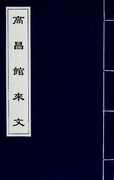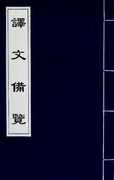Hanlin Academy
The Hanlin Academy (Chinese: 翰林院; pinyin: Hànlín Yuàn; literally: "brush wood court") was an academic and administrative institution founded in the eighth century Tang dynasty China by Emperor Xuanzong.
Membership in the academy was confined to an elite group of scholars, who performed secretarial and literary tasks for the court. One of its main duties was to decide on an interpretation of the Confucian classics. This formed the basis of the Imperial examinations, which aspiring bureaucrats had to pass to attain higher level posts. Painters working for the court were also attached to the academy.
Academy members
Some of the more famous academicians of Hanlin were:
- Li Bai (701—762) - Poet.
- Bai Juyi (772—846) - Poet.
- Ouyang Xiu (1007—1072) - Historian.
- Shen Kuo (1031—1095) - Chancellor.
- Zhang Zeduan (1085—1145) - Painter
- Zhao Mengfu (1254—1322) - Painter, calligrapher, poet (rector, 1314–1320).
- Zeng Guofan (1811-1872) - Scholar and later key military official
- Weng Tonghe (1830—1904) - Imperial Tutor.
- Cai Yuanpei (1868—1940) - Educator.
A Ming dynasty Emperor granted a hereditary title within the Hanlin academy to a descendant of Mencius.
Bureau of Translators
Subordinated to the Hanlin Academy was the Bureau of Translators (Chinese: 四夷館/四译館; pinyin: Sìyí Guǎn/Sìyì Guǎn; Wade–Giles: Szu4-i2 Kuan3/Szu4-i4 Kuan3). Founded by the Ming dynasty in 1407, after the first expedition of Zheng He to the Indian Ocean, the Bureau dealt with the memorials delivered by foreign ambassadors and trained foreign language specialists. It included departments for the Jurchen, "Tartar" (Mongol), Tibetan, "Huihui" (the "Muslim" language, Persian) and Burmese languages, as well as for the languages of the "various barbarian tribes" (Bai yi 百夷, i.e., Shan ethnic groups on China's southwestern borders), "Gaochang" (people of Turfan, i.e. Old Uyghur language), and Xitian (西天; (Sanskrit, spoken in India)). In 1511 and 1579 departments for the languages of Ba bai (八百; Lao) and Thai were added, respectively.[1] When the Qing dynasty revived the Ming Siyiguan 四夷館, the Manchus, who "were sensitive to references to barbarians", changed the name from yi 夷 "barbarian" to yi 彝 "Yi people", and changed the Shan exonym from Baiyi 百夷 "hundred barbarians" to Baiyi 百譯 "hundred translations".[2]
The later Tongwen Guan set up by the Qing dynasty for translating western languages was subordinated to the Zongli Yamen and not the Hanlin.
Foreign language vocabularies
- wikisource:zh:華夷譯語 - 達達館(蒙古語)Mongol language
- 華夷譯語(一) - 暹羅館(泰語) 天文門。 Thai language
- 華夷譯語(二) - 緬甸館譯語 緬甸館來文(緬甸語)通用門。Burmese language
- 華夷譯語(三) - 百夷館(雲南傣語)天文門。Baiyi (Dai, Shan)
- 華夷譯語(四) - 百夷館(雲南傣語)天文門和地理門。Baiyi (Dai, Shan)
- 華夷譯語(五) - 回回館《回回館雜字》(波斯語)天文門。Persian language
- 華夷譯語(六) - 回回館《回回館雜字》(波斯語)天文門和地理門。Persian language
- 高昌館來文 - 高昌館來文(高昌)回鶻語 (畏兀兒館(回鶻語))。Old Uyghur language
- 譯文備覽 - 譯文備覽 西番館(藏語)。Tibetan language
- 西番譯語 - 《西番譯語》西番館(藏語)Tibetan language
- wikisource:zh:華夷譯語/朝鮮館譯語 Korean language
- wikisource:zh:使琉球錄 (陳侃)#.E5.A4.B7.E8.AA.9E.EF.BC.88.E9.99.84.EF.BC.89 Ryukyuan language
- wikisource:zh:使琉球錄 (蕭崇業)/附#.E5.A4.B7.E8.AA.9E - 使琉球錄 夷語 夷字 Ryukyuan language
- wikisource:zh:中山傳信錄/卷六#.E9.A2.A8.E4.BF.97 Ryukyuan language
- wikisource:zh:重修使琉球錄 Ryukyuan language
- 使琉球录三种-夷语(附)_国学导航 Ryukyuan language
- 0-使琉球录-明-陈侃 Ryukyuan language
- 國朝典故卷之一百二 使琉球錄(明)陳侃 撰 Ryukyuan language
- 《女直館》(女真語) 《女真譯語》《女真館雜字》在 Die Sprache und Schrift der Jučen by Wilhem Grube by Wilhem Grube 《女真文和女真語》作者:葛祿博 Jurchen language
|
1900 fire
The Academy and its library were severely damaged in a fire during the siege of the Foreign Legations in Beijing in 1900 by the Kansu Braves while fighting against the Eight Nation Alliance. On June 24 the fire spread to the Academy:
The old buildings burned like tinder with a roar which drowned the steady rattle of musketry as Tung Fu-shiang's Moslems fired wildly through the smoke from upper windows.
Some of the incendiaries were shot down, but the buildings were an inferno and the old trees standing round them blazed like torches.
An attempt was made to save the famous Yung Lo Ta Tien, but heaps of volumes had been destroyed, so the attempt was given up.—Eyewitness Lancelot Giles, son of Herbert A. Giles[3]
Many ancient texts were destroyed by the flames.[4]
The Academy operated continuously until its closure during the 1911 Xinhai Revolution.
See also
- Education in China
- Academies (China)
Further reading
- Martin, William Alexander Parsons (1880). Hanlin Papers: Or, Essays on the Intellectual Life of the Chinese. Trübner & Company. Retrieved 24 April 2014.
- Sparks, Jared; Everett, Edward; Lowell, James Russell et al., eds. (1874). The North American Review, Volume 119. American periodical series, 1800-1850 (Issue 30409 of Library of American civilization). O. Everett. Retrieved 24 April 2014.
References
- ↑ Norman Wild (1945), "Materials for the Study of the Ssŭ i Kuan 四夷(譯)館 (Bureau of Translators)", Bulletin of the School of Oriental and African Studies, University of London 11 (3): 617–640, doi:10.1017/s0041977x00072311, JSTOR 609340; pp. 617-618.
- ↑ Wild (1945), p. 620.
- ↑ "BOXER REBELLION // CHINA 1900". HISTORIK ORDERS, LTD WEBSITE. Archived from the original on Feb 12, 2005. Retrieved 2008-10-20.
- ↑ Diana Preston (1999). The Boxer Rebellion: The Dramatic Story of China's War on Foreigners That Shook the World in the Summer of 1900. pp. 138–140. ISBN 0-8027-1361-0.
.pdf.jpg)
.pdf.jpg)
.pdf.jpg)
.pdf.jpg)
.pdf.jpg)
.pdf.jpg)

